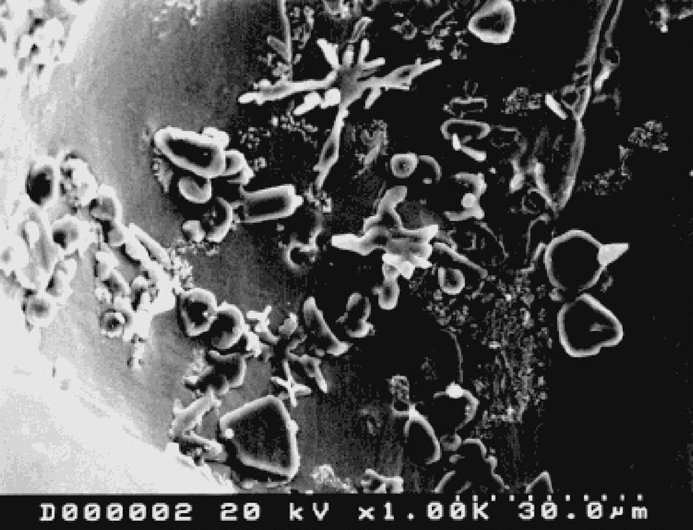
Alphabetical Index
Chemical Composition
Keyword Search
Named Inclusions
Steel Index
Exogenous Inclusions
Indigenous Inclusions
Macro Inclusions
Micro Inclusions
Nano Inclusions
Iron Oxide Inclusions
Nitride Inclusions
Oxide Inclusions
Phosphide Inclusions
Silicate Inclusions
Spinel Inclusions
Sulfide Inclusions
Refractory Inclusions
Slag Inclusions
Figure Browser
Help
Contact Us
Home
Al2O3 cluster inside of bubble in ultra low carbon steel


Figure 1: Al2O3 cluster inside of bubble. SEM, scale bars: 100, 30 µm.
Inclusion name: Al2O3 cluster
Record No.: 859
Inclusion formula: Al2O3
Inclusion type (Macro/Micro/Nano): Micro and macro
Inclusion type (Exogenous/Indigenous): Indigenous
Inclusion classification: Oxide
Inclusion composition in weight %: No data
Sample: Ultra low carbon steel
Steel composition in weight %: Low S: <0.002% C, 0.22% Mn, 0.018% P, 0.006% S, 0.037% Al-s, 0.047% Ti, <0.005% Nb, 0.002% N. High S: <0.002% C, 0.18% Mn, 0.018% P, 0.018% S, 0.029% Al-s, 0.049% Ti, <0.005% Nb, 0.003% N.
Note: The sliver defects which occur easily on ultra low carbon steel sheet are the most harmful defects, especially to automobile outer panel products. There may be many causes of the sliver defects such as nonmetallic inclusions, bubbles, surface cracks and inner cracks. However, crack formation is not a serious problem in continuously cast ultra low carbon steel because of its good ductility at high temperatures. Therefore, it is important to reduce the amount of nonmetallic inclusions and bubbles just below the slab
surface. Electro-Magnetic Stirring in the mold (M-EMS) is an effective tool to remove such bubbles and reduce the amount of the sliver defects, although the effects of M-EMS on the reduction in sliver defects are influenced by the chemical composition of steel, especially by the sulphur content.
In order to improve the surface quality of the production of ultra low carbon steel sheet used for automobiles, it is important to reduce the nonmetallic inclusions and bubbles
(blowhole defects) which exist just below the surface of continuously cast slab. Al2O3 clusters are often found on the inner surface of a bubble as shown in Fig. 1.
Reference: Not shown in this demo version.